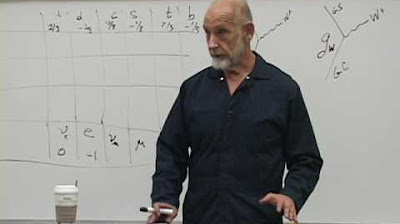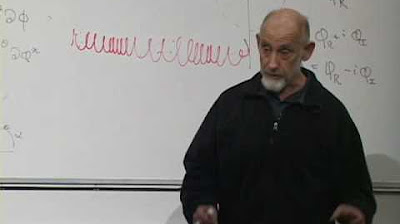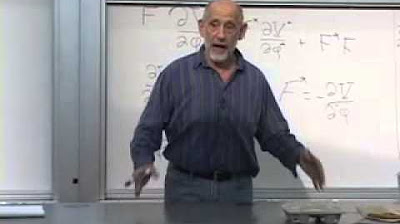Particle Physics is Founded on This Principle!
TLDRThis script delves into the Standard Model of particle physics, highlighting its predictive power and foundation on symmetry, particularly the gauge symmetry SU(3) x SU(2) x U(1). The video aims to explain the connection between symmetries and conservation laws through Noether's theorem, focusing on the U(1) symmetry and electric charge conservation. It outlines how local conservation laws arise in field theory, the role of the continuity equation, and the identification of the U(1) symmetry in electromagnetism. The script further explores the concept of gauge theory by combining the Klein-Gordon theory with electromagnetism, introducing the idea of scalar electrodynamics, and touching upon the Higgs mechanism. The video concludes with a teaser on quantum electrodynamics (QED), the first piece of the Standard Model to be understood, and the importance of gauge symmetries in particle physics.
Takeaways
- 📐 The Standard Model of particle physics is a highly predictive theory built on the foundation of symmetry, typically denoted by its gauge symmetry group SU(3) x SU(2) x U(1).
- 🔗 Conservation laws are deeply connected to symmetries in physics, as expressed by Noether's theorem, which states that every symmetry corresponds to a conserved quantity.
- 🌐 Local conservation laws in field theory, such as the conservation of electric charge, are expressed through continuity equations relating charge density and current density.
- 🤔 The U(1) symmetry associated with electromagnetism is responsible for the conservation of electric charge, as explained by Noether's theorem.
- 🧲 Electromagnetic forces are propagated by electric and magnetic fields, which interact with charged particles and are central to the U(1) symmetry in the Standard Model.
- 📈 The concept of local charge conservation means that the amount of charge can only change within a region if a current is continuously carrying charge in or out.
- 🚀 The Higgs mechanism, which gives mass to particles, is integral to understanding the electromagnetic force within the context of the Standard Model, but is a topic for a future discussion.
- 📚 Blinkist is an app that provides summaries of nonfiction books and podcasts, allowing users to grasp key insights in a short amount of time.
- ⏳ The Klein-Gordon equation is a relativistic wave equation that results from applying the principle of least action to a field theory, and it generalizes the wave equation.
- 🤓 The U(1) symmetry in field theory is a rotational symmetry in the complex plane of the field, and it is closely related to the conservation of electric charge.
- 🔋 The electromagnetic potential is introduced through the covariant derivative, which combines the ordinary derivative with a term involving the potential, and it is crucial for the gauge invariance of the Lagrangian.
Q & A
What is the Standard Model of particle physics?
-The Standard Model of particle physics is a highly predictive theory that describes the fundamental particles and forces of the universe. It is built on the foundation of symmetry and is typically denoted by its symmetry group SU(3) x SU(2) x U(1).
What is the connection between symmetries and conservation laws in physics?
-Symmetries and conservation laws are deeply connected in physics. Noether's theorem states that for every continuous symmetry in a system, there is a corresponding conserved quantity. For example, translation symmetry in space leads to momentum conservation.
What is the gauge symmetry of the Standard Model?
-The gauge symmetry of the Standard Model is a special kind of field theory that describes the fundamental forces and particles. It is associated with the symmetry group SU(3) x SU(2) x U(1), which corresponds to the strong, weak, and electromagnetic forces, respectively.
How is the conservation of electric charge related to a symmetry in the Standard Model?
-The conservation of electric charge is related to a U(1) symmetry in the Standard Model. This local conservation law is stronger than just the statement that the total amount of electric charge in the universe is constant; it means that charge is conserved at every point in space and time.
What is the role of the Higgs field in the context of electromagnetism?
-The Higgs field plays a crucial role in the mechanism that gives particles their mass. In the context of electromagnetism, the Higgs mechanism is responsible for the emergence of the electromagnetic force from the U(1) symmetry after the Higgs field acquires a non-zero value.
What is the continuity equation in the context of electromagnetism?
-The continuity equation in electromagnetism is a mathematical statement that captures the local conservation of electric charge. It relates the change in charge density (ρ) to the divergence of the current density (J), stating that the rate of change of charge within a volume is equal to the net current flowing out of that volume.
What is the significance of the U(1) symmetry in electromagnetism?
-The U(1) symmetry in electromagnetism is associated with the conservation of electric charge. It is a continuous symmetry that allows for the rotation of complex fields in the complex plane, leading to the conservation of the number of particles minus the number of antiparticles, which corresponds to the electric charge.
How does the principle of least action apply to field theory?
-The principle of least action is used in field theory to derive the equations of motion for fields. By applying this principle, one varies the action integral (which is the integral of the Lagrangian density over space and time) and sets the variation to zero, leading to the equations that describe how the fields evolve over time.
What is a gauge theory and how does it relate to the Standard Model?
-A gauge theory is a type of field theory in which the Lagrangian is invariant under a continuous group of local transformations. In the context of the Standard Model, gauge symmetries are promoted to local symmetries, which means that the symmetry transformations can vary from point to point in space-time. This is fundamental to the description of the fundamental forces and particles in the Standard Model.
What is the Klein-Gordon equation and how does it relate to the Lagrangian?
-The Klein-Gordon equation is a relativistic wave equation that arises from applying the principle of least action to a Lagrangian density that describes a free scalar field. It is a second-order partial differential equation that is used to describe particles with non-zero rest mass in quantum field theory.
How does the electromagnetic potential enter into the Lagrangian for a charged field?
-In a gauge theory like electromagnetism, the electromagnetic potential (denoted as A_mu) is introduced through the covariant derivative, which replaces the ordinary derivative in the Lagrangian. This ensures that the Lagrangian remains invariant under local U(1) gauge transformations, which is essential for the conservation of electric charge.
Outlines
📚 Introduction to Particle Physics and Symmetry
The paragraph introduces the Standard Model of particle physics, emphasizing its predictive power and foundation on symmetry. It mentions the gauge symmetry of the Standard Model, denoted as SU(3) x SU(2) x U(1), and highlights the connection between symmetries and conservation laws, as per Noether's theorem. The focus is on the symmetry of electromagnetism, U(1), and its associated conserved quantity, electric charge. The script outlines the plan to explore gauge theory through the lens of electromagnetism and to understand how local conservation laws arise in field theory.
🌐 Local Conservation Laws and Electromagnetism
This paragraph delves into the concept of local conservation of electric charge, which is essential for understanding how conservation laws emerge from symmetries in field theory. It explains the measurement of charge within a region of space and how charge conservation implies that the only way the charge within a volume can change is through the movement of charge across the boundary, represented as an electric current. The paragraph also introduces the continuity equation, which is central to expressing local charge conservation and leads to the identification of the U(1) symmetry associated with electric charge conservation.
🔗 The Continuity Equation and Field Theory
The paragraph explains how the continuity equation is derived from an infinitesimally small volume, transforming the integral equation into a differential form. It discusses the role of the continuity equation in formulating Noether's theorem for field theory and how it provides a direct local statement of electric charge conservation. The text also covers the divergence theorem, which allows the transformation of an integral over a boundary surface into an integral of derivatives over a volume, leading to the continuity equation.
🤔 Symmetry and Conservation in Field Theory
The focus shifts to understanding the U(1) symmetry of the standard model and how it relates to the conservation of electric charge within a generalized field theory. The paragraph explores the concept of a complex field and its Lagrangian, which has a rotational symmetry in the complex plane. This symmetry is tied to electric charge conservation, and the paragraph outlines how Noether's theorem can be applied to this symmetry to derive a conservation law.
🔄 U(1) Symmetry and Conservation of Electric Charge
This paragraph discusses the U(1) symmetry in the context of the Klein-Gordon theory and how it leads to the conservation of electric charge. It explains the transformation of the field under U(1) symmetry and how the Lagrangian is invariant under this transformation. The application of Noether's theorem to this symmetry results in a local conservation law, which is identified with the conservation of electric charge. The densities rho and j from the rotation symmetry correspond to electric charge and current densities, respectively.
🧲 Electromagnetic Fields and Gauge Theory
The paragraph introduces the Lagrangian for the full theory, including electromagnetic fields, and explains how to incorporate these fields into the theory. It discusses the concept of a covariant derivative, which includes the electromagnetic potential, and how it restores the invariance of the Lagrangian under local U(1) transformations. The paragraph also outlines the Lagrangian for pure electromagnetism and how it gives rise to Maxwell's equations when the principle of least action is applied.
🚀 Conclusion and Tease for Quantum Electrodynamics
The final paragraph summarizes the key points discussed in the script, which include the connection between symmetries and conservation laws in field theory, the U(1) symmetry associated with electric charge conservation, and the incorporation of electromagnetic fields into the theory. It also teases the concept of scalar electrodynamics and introduces quantum electrodynamics (QED), which is the most fundamental theory of electromagnetism and the first piece of the Standard Model to be understood. The paragraph concludes with an invitation to explore more details in future lessons and thanks the viewer for watching.
Mindmap
Keywords
💡Standard Model
💡Symmetry
💡Conservation Laws
💡Gauge Theory
💡U(1) Symmetry
💡Electric Charge
💡Continuity Equation
💡Higgs Mechanism
💡Lagrangian
💡Noether's Theorem
💡Electromagnetic Potential
Highlights
The Standard Model of particle physics is built on the foundation of symmetry, specifically the gauge symmetry group SU(3) x SU(2) x U(1).
Symmetries in physics are profoundly connected to conservation laws, as captured by Noether's theorem.
Translation symmetry in space is tied to momentum conservation, while rotational symmetry leads to angular momentum conservation.
Energy conservation is a result of translation symmetry in time, according to Noether's theorem.
In field theory, the connection between symmetries and conservation laws is even deeper, exemplified by local charge conservation in electromagnetism.
The conservation of electric charge is a local phenomenon, meaning it can only change if a current carries charge in or out of a region.
The U(1) symmetry associated with electromagnetism is responsible for the conservation of electric charge, as per Noether's theorem.
The electromagnetic force is a different but related U(1) that sits inside the Standard Model's symmetry group, becoming apparent after the Higgs field's role.
The Higgs mechanism will be covered in a future video, which is crucial for understanding the Standard Model's symmetries.
The local conservation of charge is mathematically expressed by the continuity equation, which connects charge density and current density.
The U(1) symmetry of the Standard Model is understood by examining the local conservation of electric charge in electromagnetism.
The divergence theorem is used to derive the continuity equation, which is essential for formulating Noether's theorem for field theory.
The Lagrangian density for a complex field exhibits rotational symmetry in the complex plane, which is analogous to the symmetry of a block on a spring.
The U(1) symmetry in field theory is a rotational symmetry, where the complex field transforms as phi goes to e^(i*alpha)*phi.
Noether's theorem guarantees that for every continuous symmetry in a field theory, there is a corresponding local conservation law.
The Klein-Gordon equation is derived from the principle of least action applied to the Lagrangian density of a field theory.
The full theory including electromagnetic fields is formulated using the Lagrangian for scalar electrodynamics, which is a precursor to Quantum Electrodynamics (QED).
Quantum Electrodynamics (QED) is the quantum field theory of electrodynamics, describing the interactions between charged particles and electromagnetic fields.
Transcripts
Browse More Related Video

Lecture 6 | New Revolutions in Particle Physics: Standard Model

Lecture 7 | New Revolutions in Particle Physics: Standard Model

The Symmetries of the universe

Electroweak Theory and the Origin of the Fundamental Forces

Supersymmetry & Grand Unification: Lecture 9

Lecture 5 | New Revolutions in Particle Physics: Standard Model
5.0 / 5 (0 votes)
Thanks for rating: